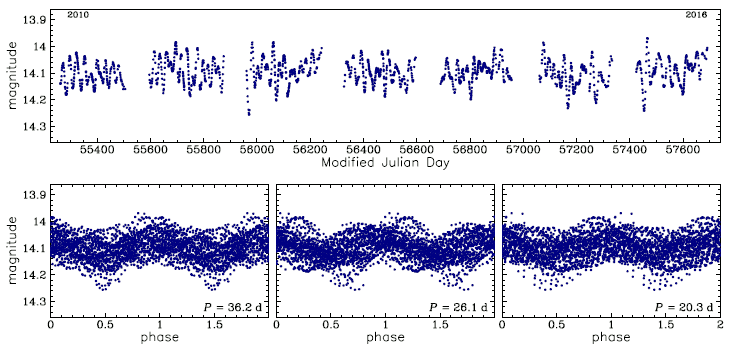OGLE Small Amplitude Red Giants (OSARGs)
The term OGLE small amplitude red giant (OSARG) was coined by Laurent Eyer and used for the first time in the paper by Wray, Eyer, and Paczyński (2004) describing an analysis of over 15,000 such objects identified in the public domain OGLE catalog of variable stars. OSARGs are red giant branch (RGB) or asymptotic giant branch (AGB) pulsating stars with periods ranging from about 10 days to just over 100 days. These stars form a complex series of period-luminosity sequences of which the longest-period ridge roughly overlaps with sequence C'. Additionally, at least 30% of OSARG variables show long secondary periods that follow period-luminosity sequence D. RGB OSARGs obey period-luminosity relations that are somewhat shifted (in period) relative to the AGB OSARGs.
Amplitudes of the light variations are strongly correlated with the absolute brightness of the OSARG variables. The faintest OSARGs have amplitudes of a few milimagnitudes - just above the detection limit of the OGLE ground-based photometry. Even smaller amplitudes have been observed for fainter giants by space-borne telescopes. Light curves of the brightest OSARGs can have amplitudes of periodic components of about 0.2 magnitudes (in the I-band), but many of them exhibit additional irregular changes with much larger amplitudes. Left panels in the pictures below show unfolded I-band light curves obtained during the first 5 years of the OGLE-IV project (2010-2014). Right panels show the same photometric data folded with the primary period.
OSARG light curves are always multiperiodic and generally resemble those of semiregular variables. In fact, both classes of long-period variables constitute an evolutionary continuity. During their evolution on the AGB, OSARGs turn into semiregular variables which then become Mira stars. However, OSARG variables obey a different set of period-luminosity relations (sequences A, A', B, ...) than semiregular variables (sequences C and C') and usually have a larger number of pulsation modes excited. OSARGs typically oscillate simultaneously in three, four, or even more radial and non-radial modes. The upper panel in the picture below shows unfolded time-series data of an OSARG variable from the Galactic bulge. Three lower panels show exactly the same light curve folded with different pulsation periods excited in this star.
 |
More or less sophisticated methods can be used to examine multiperiodicity in pulsating stars. In these cases, the three pulsation periods are clearly visible in the original light curves.
And one more example of a multimode OSARG variable.
| 